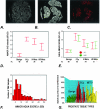Quantitative determination of expression of the prostate cancer protein alpha-methylacyl-CoA racemase using automated quantitative analysis (AQUA): a novel paradigm for automated and continuous biomarker measurements
- PMID: 14982837
- PMCID: PMC1613273
- DOI: 10.1016/s0002-9440(10)63171-9
Quantitative determination of expression of the prostate cancer protein alpha-methylacyl-CoA racemase using automated quantitative analysis (AQUA): a novel paradigm for automated and continuous biomarker measurements
Abstract
Despite years of discovery and attempts at validation, few molecular biomarkers achieve acceptance in the clinical setting. Tissue-based markers evaluated by immunohistochemistry suffer from a high degree of inter- and intraobserver variability. One recent advance in this field that promises to automate this process is the development of AQUA, a molecular-based method of quantitative assessment of protein expression. This system integrates a set of algorithms that allows for the rapid, automated, continuous, and quantitative analysis of tissue samples, including the separation of tumor from stromal elements and the subcellular localization of signals. This study uses the AQUA system to assess a recently described prostate cancer biomarker, alpha-methylacyl-CoA-racemase (AMACR), and to determine the effectiveness of the quantitative measurement of this marker as a means for making the diagnosis of prostate cancer. Using a prostate cancer progression tissue microarray containing a wide range of prostate tissues, AQUA was directly compared to standard immunohistochemical evaluation for AMACR protein expression using the p504s monoclonal antibody. Both methods produced similar results showing AMACR protein expression to be strongest in the clinically localized prostate cancer, followed by the metastatic tumor samples. Benign prostate tissue was categorized as negative for most tissue samples by immunohistochemistry. However, AMACR was detectable using the AQUA system at low levels using the standard 1:25 dilution but also at 1:250 dilution, which is not detectable by light microscopy. The AQUA system was also able to discriminate foamy gland prostate cancers, which are known to have a lower AMACR expression than typical acinar prostate cancers, from benign prostate tissue samples. Finally, a receiver-operating-characteristic curve was plotted to determine the specificity of the AMACR AQUA Z-score (normalized AQUA score) to predict that a given tissue microarray sample contains cancer. The area under the curve was calculated at 0.90 (P < 0.00001; 95% CI, 0.84 to 0.95). At an AMACR AQUA Z-score score of -0.3, 91% of the 70 samples classified as prostate cancer were correctly categorized without the intervention of a pathologist reviewing the tissue microarray slide. In conclusion, the AQUA system provides a continuous measurement of AMACR on a wide range of prostate tissue samples. In the future, the AMACR AQUA Z-score may be useful in the automated screening and evaluation of prostate tissue biomarkers.
Figures




Similar articles
-
Expression and diagnostic utility of alpha-methylacyl-CoA-racemase (P504S) in foamy gland and pseudohyperplastic prostate cancer.Am J Surg Pathol. 2003 Jun;27(6):772-8. doi: 10.1097/00000478-200306000-00007. Am J Surg Pathol. 2003. PMID: 12766580
-
alpha-Methylacyl coenzyme A racemase as a tissue biomarker for prostate cancer.JAMA. 2002 Apr 3;287(13):1662-70. doi: 10.1001/jama.287.13.1662. JAMA. 2002. PMID: 11926890
-
Foamy gland carcinoma of the prostate in needle biopsy: incidence, Gleason grade, and comparative α-methylacyl-CoA racemase vs. ERG expression.Am J Surg Pathol. 2013 Nov;37(11):1709-14. doi: 10.1097/PAS.0b013e318293d85b. Am J Surg Pathol. 2013. PMID: 23797726
-
Discovery and clinical application of a novel prostate cancer marker: alpha-methylacyl CoA racemase (P504S).Am J Clin Pathol. 2004 Aug;122(2):275-89. doi: 10.1309/EJUY-UQPE-X1MG-68MK. Am J Clin Pathol. 2004. PMID: 15323145 Review.
-
Application of alpha-methylacyl coenzyme A racemase immunohistochemistry in the diagnosis of prostate cancer: a review.Anal Quant Cytol Histol. 2006 Feb;28(1):1-13. Anal Quant Cytol Histol. 2006. PMID: 16566275 Review.
Cited by
-
Early detection in head and neck cancer - current state and future perspectives.GMS Curr Top Otorhinolaryngol Head Neck Surg. 2008;7:Doc06. Epub 2010 Oct 7. GMS Curr Top Otorhinolaryngol Head Neck Surg. 2008. PMID: 22073093 Free PMC article.
-
Quantitative analysis of p53 expression in human normal and cancer tissue microarray with global normalization method.Int J Clin Exp Pathol. 2011 Jun 20;4(5):505-12. Epub 2011 Jun 15. Int J Clin Exp Pathol. 2011. PMID: 21738821 Free PMC article.
-
Targeting androgen receptor in estrogen receptor-negative breast cancer.Cancer Cell. 2011 Jul 12;20(1):119-31. doi: 10.1016/j.ccr.2011.05.026. Cancer Cell. 2011. PMID: 21741601 Free PMC article.
-
Live cell in vitro and in vivo imaging applications: accelerating drug discovery.Pharmaceutics. 2011 Apr 4;3(2):141-70. doi: 10.3390/pharmaceutics3020141. Pharmaceutics. 2011. PMID: 24310493 Free PMC article.
-
Image analysis algorithms for immunohistochemical assessment of cell death events and fibrosis in tissue sections.J Histochem Cytochem. 2009 Jul;57(7):649-63. doi: 10.1369/jhc.2009.952812. Epub 2009 Mar 16. J Histochem Cytochem. 2009. PMID: 19289554 Free PMC article.
References
-
- Dowsett M, Bartlett J, Ellis IO, Salter J, Hills M, Mallon E, Watters AD, Cooke T, Paish C, Wencyk PM, Pinder SE. Correlation between immunohistochemistry (HercepTest) and fluorescence in situ hybridization (FISH) for HER-2 in 426 breast carcinomas from 37 centres. J Pathol. 2003;199:418–423. - PubMed
-
- Paik S, Bryant J, Tan-Chiu E, Romond E, Hiller W, Park K, Brown A, Yothers G, Anderson S, Smith R, Wickerham DL, Wolmark N. Real-world performance of HER2 testing—National Surgical Adjuvant Breast and Bowel Project experience. J Natl Cancer Inst. 2002;94:852–854. - PubMed
-
- Fernandez PL, Arce Y, Farre X, Martinez A, Nadal A, Rey MJ, Peiro N, Campo E, Cardesa A. Expression of p27/Kip1 is down-regulated in human prostate carcinoma progression. J Pathol. 1999;187:563–566. - PubMed
-
- Yang RM, Naitoh J, Murphy M, Wang HJ, Phillipson J, deKernion JB, Loda M, Reiter RE. Low p27 expression predicts poor disease-free survival in patients with prostate cancer. J Urol. 1998;159:941–945. - PubMed
-
- Guo Y, Sklar GN, Borkowski A, Kyprianou N. Loss of the cyclin-dependent kinase inhibitor p27 (Kip1) protein in human prostate cancer correlates with tumor grade. Clin Cancer Res. 1997;3:2269–2274. - PubMed
Publication types
MeSH terms
Substances
Grants and funding
LinkOut - more resources
Full Text Sources
Other Literature Sources
Medical

